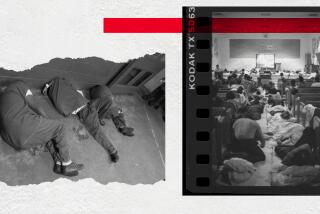Inmates Losing Space as Prisons Add Bunks
- Share via
In a new sign of strain on California’s overcrowded prison system, inmates at 14 lockups are being housed in some of the last spaces available to corrections officials -- the “dayrooms,” or communal spaces where prisoners watch TV, mingle and play cards.
The emergency move -- outlined in a state Department of Corrections memo obtained this week by The Times -- is being enacted as new inmates, primarily from Los Angeles County, continue to flood the prison system despite predictions from corrections officials that the convict population would decrease this summer.
For the record:
12:00 a.m. July 29, 2004 For The Record
Los Angeles Times Thursday July 29, 2004 Home Edition Main News Part A Page 2 National Desk 0 inches; 25 words Type of Material: Correction
Prison spokeswoman -- An article about state prison crowding in Wednesday’s California section misspelled the name of Corrections Department spokeswoman Margot Bach as Margo Bach.
For years, state prison officials have found creative ways to deal with chronic overcrowding, often by converting gymnasiums to dormitories. But moving bunk beds and prisoners into dayrooms has raised new safety concerns as convicted felons jostle for a shrinking slice of elbow room. And it has some insiders wondering how much worse the crowding can get.
“This is it -- we’re to the rim,” said Lt. Charles Hughes of the state prison in Lancaster, where four dayrooms are now jammed with full-time inhabitants. “Let’s hope people stop committing crime.”
California’s prison system -- the nation’s largest, with an inmate population of about 160,000 since the late 1990s -- has operated at or near capacity for years, corrections officials say. No new prison has opened since 1997, and the only one under construction, called Delano II in Kern County, will not open until April.
The new crisis has emerged as good news collides with bad. In Los Angeles County, aggressive policing -- spurred in part by Chief William J. Bratton’s policies in the Los Angeles Police Department -- has pushed total arrests up by more than 10%, according to Los Angeles County Sheriff’s Chief Chuck Jackson, who oversees the booking and release of inmates at county jails.
“We’re on track for booking 180,000 inmates into our system this year. That’s [about] 25,000 more than last year,” Jackson said.
But the deluge of new convicts has overwhelmed the beleaguered and cash-strapped state prisons.
By this spring, corrections officials had hoped that new alternatives to prison for parole violators -- such as rehabilitation programs and house arrests -- would lower the inmate population. Instead, the prisons have had to deal with 1,200 unexpected inmates, many from Los Angeles County jails.
In response, the Corrections Department began “triple-bunking” inmates in dormitories at three prisons where the norm had been two-bed bunks.
In mid-July, another unexpected wave of L.A. County inmates numbering nearly 1,800 began arriving.
The new plan calls for adding more than 2,600 beds this month and in August to accommodate the increase. Most of the beds are being set up in dayrooms and former vocational classrooms closed due to budget cuts.
Margo Bach, a spokeswoman for the Corrections Department, could not say whether the new arrangements were temporary. “One would hope,” she said.
“We don’t like putting them in dayrooms,” she said. “But we have no choice in this matter when we’re receiving the number of inmates that we are.”
Bach also could not say whether the conversion of dayrooms to dorms was unprecedented. But a number of veteran officers said they could not remember such a drastic move.
In the early 1990s, the Los Angeles County Sheriff’s Department began housing its prisoners in dayrooms to relieve overcrowding at its downtown Men’s Central Jail.
But in recent weeks, sheriff’s officials removed the beds after two inmates were killed amid the dayrooms’ clutter, Jackson said.
Corrections Lt. Hughes said the bunks block guards’ sight lines, making it more difficult for them to respond to a riot or fight.
“There’s blind spots now,” said Hughes, who is also president of the local chapter of the guards union. “The line of sight if you had to shoot is totally blocked. [Inmates] could grab an officer and drag him behind the bunk and the officers can’t shoot at him.”
Today, some Lancaster inmates housed in cells are seeing their dayroom privileges cut back because there isn’t enough space for everyone. When they do use a dayroom, they must share it with 40 inmates now living there full time.
Hughes worries that the cuts and overcrowding may increase tensions among prisoners, who count dayroom privileges among the few perks in an otherwise dreary reality.
Cayenne Bird, director of the prisoners’ rights group UNION, said her son’s dayroom in Lancaster was converted to a dorm. The move, she said, was inhumane.
Bach acknowledged the conundrum for law enforcement and corrections officials.
“You’re cleaning up the streets, and that’s a good thing,” she said. “Then you get people upset because we’re overcrowding.”
More to Read
Sign up for Essential California
The most important California stories and recommendations in your inbox every morning.
You may occasionally receive promotional content from the Los Angeles Times.













